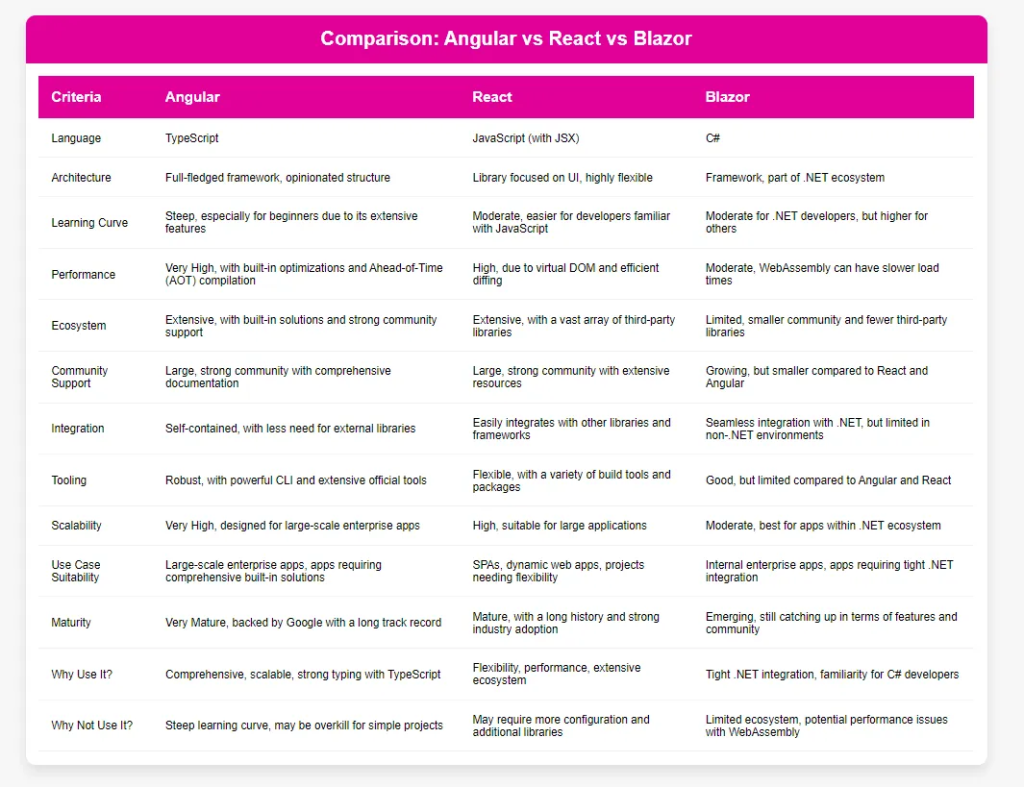When it comes to building scalable, maintainable, and robust applications, choosing the right frontend framework is essential, especially for enterprises. In this article, we’ll dive into a detailed comparison between React, Angular, and Blazor—three leading frameworks that offer unique advantages for enterprise applications. By the end, you’ll have a clearer idea of which framework is the best fit for your specific use case.
❖ Overview
React, developed and maintained by Facebook (now Meta), is a JavaScript library primarily focused on building user interfaces. It gained widespread popularity due to its flexibility and the ability to seamlessly integrate into different projects. React adopts a component-based architecture, promoting the reuse of UI elements.
⇛ Key Features
- Component-based architecture: Reusable UI components make React applications highly maintainable and modular.
- Virtual DOM: React uses a virtual DOM that optimizes rendering by only updating parts of the page that need to change.
- Strong ecosystem: Since React is just a UI library, developers can choose from a variety of libraries for routing, state management (e.g., Redux), and more.
- Backward compatibility: React’s updates rarely break existing applications, ensuring long-term support.
⇛ Advantages for Enterprises
- Performance: With the Virtual DOM and an extensive ecosystem of performance tools, React offers blazing-fast performance even for large-scale enterprise applications.
- Flexibility: Unlike full-fledged frameworks, React can be incrementally adopted in your existing tech stack without major rewrites.
- Active community and support: React has a massive developer community, ensuring abundant resources, tutorials, and tools for enterprise-scale projects.
- Cross-platform development: React Native allows enterprises to extend their React skills to mobile app development.
⇛ Downsides
- Steeper learning curve for the ecosystem: While React itself is simple, mastering the surrounding tools (like Redux, GraphQL) can be complex.
- No “batteries included”: React only handles UI, so you need to make decisions about state management, routing, and other features.
❖ Angular: A Complete Framework
⇛Overview
Angular is a TypeScript-based framework developed by Google. Unlike React, Angular is a complete front-end framework that comes with everything you need to build large-scale, enterprise-grade applications right out of the box.
⇛ Key Features
- Two-way data binding: Automatically synchronizes data between the model and view, reducing boilerplate code.
- Dependency injection: Improves modularity and testability, making it easier to manage complex applications.
- Comprehensive CLI: Angular’s CLI is powerful and speeds up development with scaffolding, testing, and deployment tools.
- RxJS for reactive programming: Offers advanced reactive capabilities, helping handle complex data streams efficiently.
⇛ Advantages for Enterprises
- Enterprise-grade tools and features: Angular provides everything needed to build complex applications without relying on third-party libraries.
- Robust structure: Angular’s structure scales well, making it suitable for enterprise teams where a strong architectural foundation is required.
- Standardized approach: Angular’s all-in-one nature means there’s less variation in how projects are set up, which can improve productivity across large teams.
- Long-term support from Google: Enterprises can rely on Angular’s support roadmap for predictable upgrades and improvements.
⇛ Downsides
- Complexity: Angular’s learning curve can be steep due to its many built-in features.
- Performance overhead: The framework’s size and complexity can sometimes lead to performance trade-offs, especially in small apps.
❖ Blazor: The .NET Contender
⇛ Overview
Blazor, developed by Microsoft, is a C#-based framework that allows developers to build interactive web UIs using Razor components. Blazor stands out because it enables full-stack development with .NET, allowing C# developers to build web applications without writing any JavaScript.
⇛ Key Features
- C# and .NET: Write both client-side and server-side code in C#, leveraging the existing .NET ecosystem.
- WebAssembly support: Blazor WebAssembly allows C# code to run directly in the browser using WebAssembly, eliminating the need for JavaScript.
- Server-side rendering: Blazor Server renders components on the server and sends updates to the browser via SignalR, reducing the amount of data sent over the wire.
- Unified tech stack: For enterprises already invested in Microsoft technologies, Blazor offers a unified technology stack for web, desktop, and mobile apps.
⇛ Advantages for Enterprises
- Leverage existing C# expertise: Enterprises with teams skilled in C# and .NET can reuse their knowledge, reducing the learning curve and enhancing productivity.
- Tight integration with Microsoft ecosystem: Blazor integrates seamlessly with Microsoft products such as Azure, making it a natural choice for enterprises already in the .NET world.
- Strong tooling and support: With Visual Studio, enterprises benefit from robust tools, debugging capabilities, and integrated CI/CD workflows.
- Single language for full-stack development: C# developers can now work on both the front end and back end, streamlining development.
⇛ Downsides
- Smaller community: Blazor is newer than React and Angular, so its community and ecosystem are not as mature.
- Performance: WebAssembly applications can have larger payload sizes, which may impact performance, especially for users on slower networks.
- Limited third-party libraries: Compared to React and Angular, Blazor’s third-party library ecosystem is still growing.
Which Framework is Best for Your Enterprise?
- React is an excellent choice for enterprises that need flexibility, performance, and a strong developer community. It works best when you need a lightweight, UI-focused library and prefer to select your own ecosystem tools.
- Angular shines when you want a comprehensive framework with built-in features like routing, forms, and dependency injection. It’s ideal for teams that prefer a more opinionated and structured approach, especially in large-scale applications.
- Blazor is the right choice for organizations already invested in the Microsoft ecosystem, or those looking for a unified development stack using .NET and C#. It’s particularly appealing to enterprises with existing C# expertise.

Each of these frameworks brings something unique to the table. The final decision should depend on your team’s expertise, the existing tech stack, and the specific needs of your enterprise application. Whether you choose React for its flexibility, Angular for its complete framework, or Blazor for its integration with .NET, you’ll be well-equipped to build a robust, scalable, and enterprise-ready front-end solution.
Happy coding https://synpass.pro/contactsynpass/ 🚀🚀🚀

